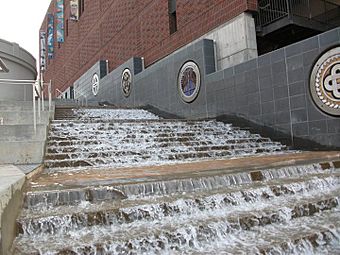Ross's Landing facts for kids
Quick facts for kids |
|
|
Ross's Landing
|
|

Water cascading down steps above Ross's Landing Riverfront Park
|
|
| Location | Riverfront Pkwy. west of Market St., Chattanooga, Tennessee |
|---|---|
| Area | 3 acres (1.2 ha) |
| NRHP reference No. | 74001914 |
| Added to NRHP | June 27, 1974 |
Ross's Landing in Chattanooga, Tennessee, is a very important historical spot. It was the last place the Cherokee people lived in Chattanooga for over 60 years. It is also known as the starting point for the Cherokee removal, a sad journey called the Trail of Tears. Today, Ross's Landing Riverfront Park remembers this location. It is listed on the National Register of Historic Places, meaning it's a special place in American history.
Contents
The Story of Ross's Landing
How Ross's Landing Got Its Name
This important spot was named after John Ross. He later became the main leader, or "principal chief," of the Cherokee Nation. In 1816, John Ross made his home here, right by the Tennessee River. He set up a place where people could trade goods, called a trading post. This trading post was on the edge of the Cherokee Nation, across the river from the United States.
People knew this area as "Ross's Warehouse" or "Ross's Ferry." It was the best place to cross the river using a flatboat. John Ross even ran a special "swing ferry" that helped people get across.
Why John Ross Moved Away
In 1826, John Ross sold his land to a minister named Nicholas Dalton Scales. He moved to Georgia to be closer to where the Cherokee Nation made its important decisions.
The Trail of Tears Begins
Later, in 1837, the United States government took over the lands owned by the Cherokee people. This began a forced move called the Indian removal, or the "Trail of Tears." During this time, Cherokee families in several states were made to leave their homes.
Many groups of Cherokee people were gathered in camps, including one near Ross's Landing. They were waiting to be forced to move west. On June 6, 1838, more than 1,500 Cherokee people left Ross's Landing. They traveled on steamboats and barges.
A final group of Cherokee had to walk in the fall of 1838. The river levels were too low for boats because of a drought. This long walk west caused many Cherokee lives to be lost, including John Ross's wife, Quatie.
After the Cherokee were forced to leave, American settlers took over the land. They changed the name from Ross's Landing to Chattanooga.
Ross's Landing Today
Remembering the Past
Today, Ross's Landing is remembered at Ross's Landing Riverfront Park. This park is on the banks of the Tennessee River, right where the city of Chattanooga started. The site was added to the National Register of Historic Places in 1974.
Park Improvements and Art
In 2005, a big project began to make Tennessee's public parks better. This included updating Ross's Landing Park. Now, a walking path connects Ross's Landing Riverfront Park to the Tennessee Aquarium.
Along this path, there is a special art display. It shows the journey the Cherokee people were forced to take to Oklahoma. This art was created by Gadugi, a group of five Cherokee artists from Oklahoma. It has seven large, carved clay medallions set into a wall. These medallions tell stories about Cherokee history, their beliefs, and the challenges they faced with settlers.



